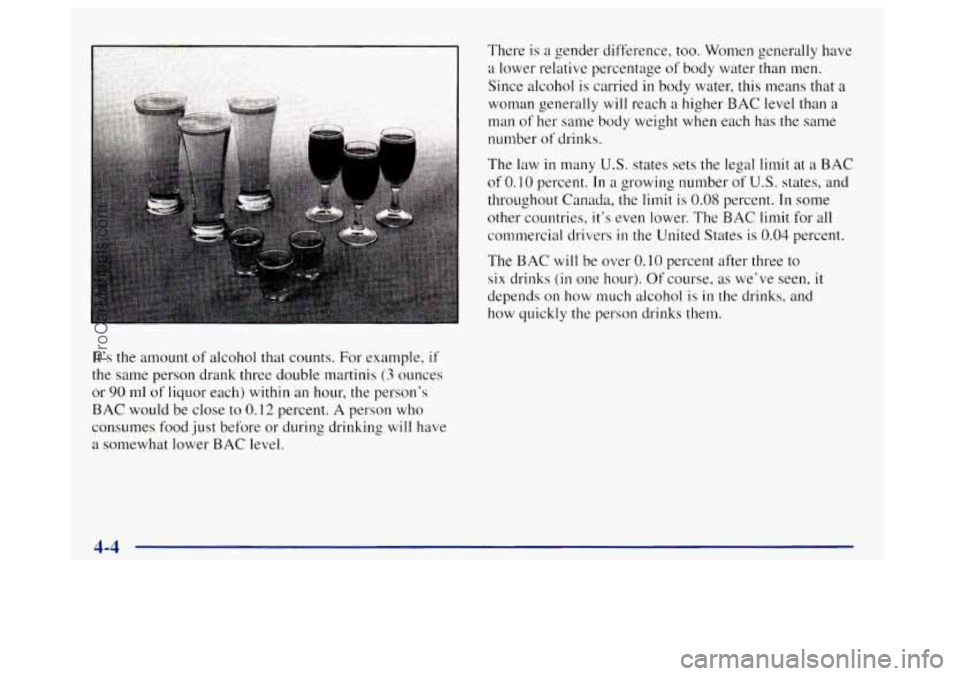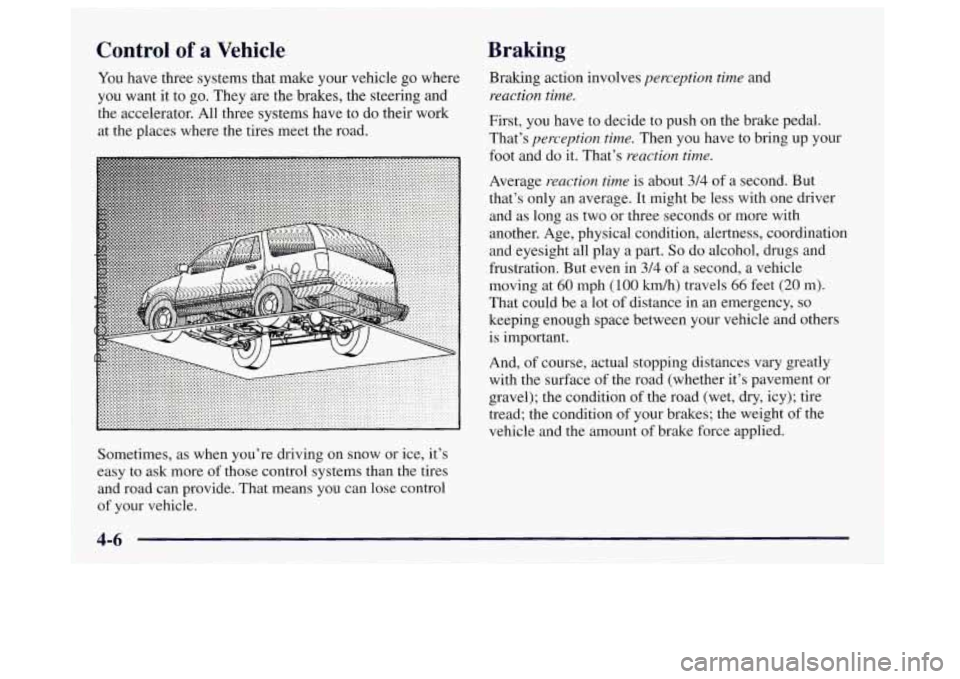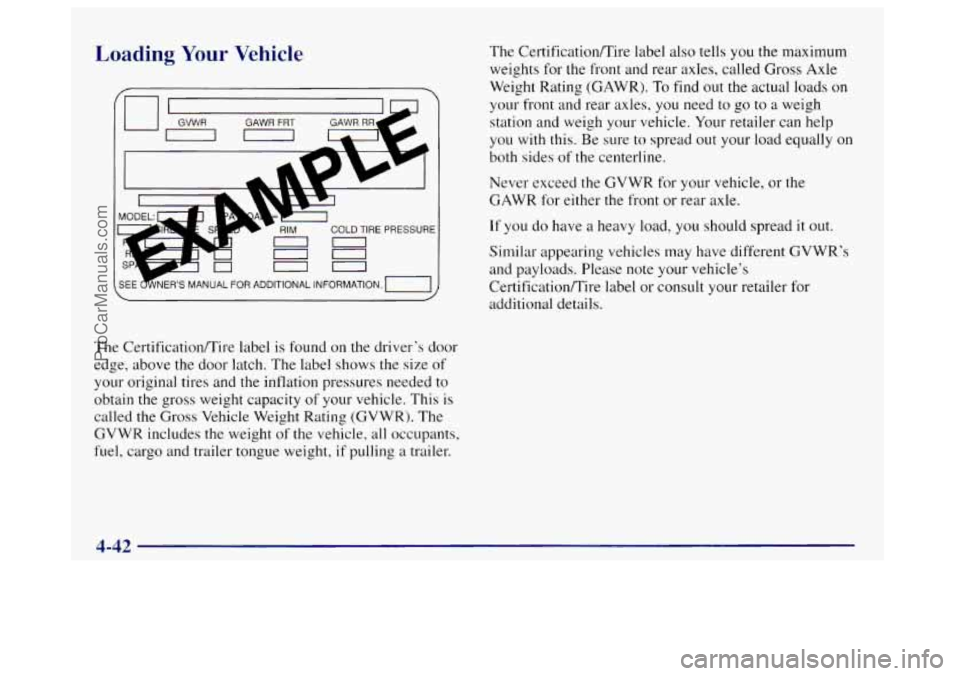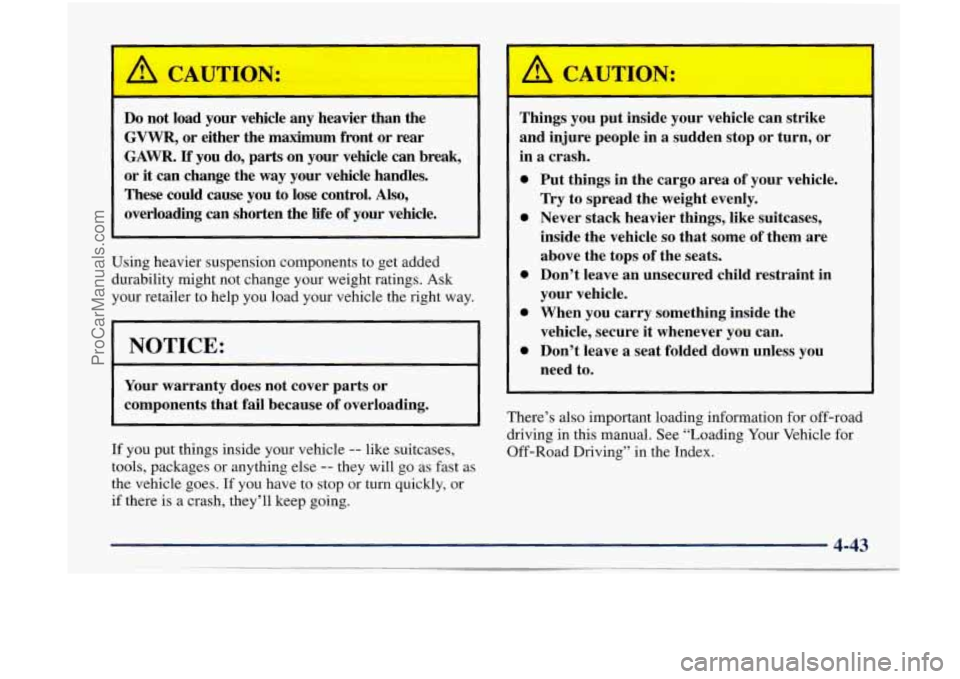weight OLDSMOBILE BRAVADA 1998 Owners Manual
[x] Cancel search | Manufacturer: OLDSMOBILE, Model Year: 1998, Model line: BRAVADA, Model: OLDSMOBILE BRAVADA 1998Pages: 380, PDF Size: 19.2 MB
Page 49 of 380

Child Restraints
Every time infants and young children ride in vehicles, they should have protection provided by appropriate restraints.
What are the different types of add-on
child restraints?
A: Add-on child restraints are available in four basic
types. When selecting a child restraint, take into consideration not only the child's weight and size,
but also whether or not the restraint will be compatible with the motor vehicle in which it
will be used.
An infant car bed
(A) is a special bed made for use
in a motor vehicle. It's an infant restraint system
designed to restrain or position a child on a
continuous flat surface. With an infant car bed,
make sure that the infant's head rests toward the
center of the vehicle.
1-37
ProCarManuals.com
Page 85 of 380

Leaving Your Vehicle With the
Engine
Running
4 CAUTION:
It can be dangerous to leave your vehicle with the
engine running. Your vehicle could move
suddenly if the shift lever is not fully in PARK
(P)
with the parking brake firmly set. And, if you
leave the vehicle with the engine running, it could
overheat and even catch fire. You or others could
be injured. Don’t leave your vehicle with the
engine running unless you have to.
If you have to leave your vehicle with the engine
running, be sure your vehicle is
in PARK (P) and your
parking brake is firmly set before you leave
it. After
you‘ve moved the shift lever into PARK (P), hold the
regular brake pedal down. Then, see
if you can move the
shift lever away from PARK (P) without first pulling it
toward you (or pressing the button on a console shift
lever).
If you can, it means that the shift lever wasn’t
fully locked into PARK (P).
Torque Lock
If you are parking on a hill and you don’t shift your
transmission into PARK (P) properly, the weight of the
vehicle may
put too much force on the parking pawl in
the transmission. You may find it difficult to pull the
shift lever out of PARK (P). This
is called “torque lock.”
To prevent torque lock, set the parking brake and then
shift into PARK (P) properly before you leave the
driver’s seat.
To find out how, see “Shifting Into
PARK
(P)” in the Index.
When you are ready
to drive, move the shift lever out of
PARK
(P) bqjot-e you release the parking brake.
If torque lock does occur, you may need to have another
vehicle push yours a little
uphill to take some of the
pressure
f1-0111 the parking pawl in the transmission, so
you can pull the shift lever out of PARK (P).
2-21
ProCarManuals.com
Page 107 of 380

Luggage Carrier
If you try to carry something on top of your
vehicle that is longer
or wider than the luggage
carrier
-- like paneling, plywood, a mattress, and
so forth -- the wind can catch it as you drive
along. This can cause you to lose control. What
you are carrying could be violently torn
off, and
this could cause you or other drivers to have
a
collision, and of course damage your vehicle. You
may be able to carry something like this inside.
But, never carry something longer or wider than
the luggage carrier on top
of your vehicle.
A luggage carrier allows you to load things on top of
your vehicle. The luggage carrier has slats and side rails
attached to
the roof, sliding crossrails and places to use
for tying things down. These let you load some other
things on top
of your vehicle, as long as they are not
wider or longer than the luggage carrier. To slide the
crossrails to where you want them, push
up
on the lever under each side of the crossrail. This will
release the crossrail and allow you to slide it. When the
crossrail
is where you want it, push down on the lever to
lock it into place.
NOTICE:
Loading cargo that weighs more than 200 Ibs.
(91 kg) on the luggage carrier may damage
your vehicle.
When
you carry cargo on the luggage carrier of a
proper size and weight, put
it on the slats, as far
forward as you can. Then slide the crossrail up
against the rear of the load, to help keep it from
moving. You can then tie it down.
Don’t exceed the lnaximum vehicle capacity when loading
your vehicle. For more information on vehicle capacity
and loading, see “Loading
YOLK Vehicle” in the Index.
To prevent damage or loss of cargo as you’re driving,
check now and then
to make sure the luggage carrier is
locked and cargo is
still securely fastened.
ProCarManuals.com
Page 155 of 380

Drunken Driving
Death and injury associated with drinking and driving
is a national tragedy. It’s the number one contributor to
the highway death toll, claiming thousands of victims
every year.
Alcohol affects four things that anyone needs to drive
a vehicle:
0 Judgment
Muscular Coordination
0 Vision
Attentiveness.
Police records show that almost half of all motor
vehicle-related deaths involve alcohol. In most cases,
these deaths are the result
of someone who was drinking
and driving. In recent years, over 17,000 annual motor
vehicle-related deaths have been associated with the use
of alcohol, with more than
300,000 people injured.
Many adults
-- by some estimates, nearly half the
adult population
-- choose never to drink alcohol, so
they never drive after drinking. For persons under 2 1, it’s
against the law in every
US. state to drink alcohol. There
are good medical, psychological and developmental
reasons for these laws. The
obvious way to solve this highway safety problem
is for people never to drink alcohol and then drive. But
what if people do?
How much is “too much” if the
driver plans to drive? It’s a lot less than many might
think. Although it depends on each person and situation,
here is some general information on the problem.
The Blood Alcohol Concentration (BAC) of someone
who is drinking depends upon four things:
0 The amount of alcohol consumed
The drinker’s body weight
0 The amount of food that is consumed before and
during drinking
The length of time it has taken the drinker to
According to the American Medical Association, a
180-lb. (82 kg) person who drinks three 12-ounce
(355 ml) bottles of beer in an hour will end up with a
BAC of about
0.06 percent. The person would reach the
same BAC by drinking three 4-ounce
(120 ml) glasses
of wine or three mixed drinks if each had 1 - 1/2 ounces
(45 ml)
of a liquor like whiskey, gin or vodka.
consume
the alcohol.
4-3
ProCarManuals.com
Page 156 of 380

It’s the amount of alcohol that counts. For example, if
the same person drank three double martinis (3 ounces
or
90 ml of liquor each) within an hour, the person’s
BAC would be close to
0.12 percent. A person who
consumes food just before or during drinking will have
a somewhat lower BAC level. There
is a gender difference, too.
Women generally have
a lower relative percentage
of body water than men.
Since alcohol
is carried in body water, this means that a
woman generally will reach a higher BAC level than a
man of her same body weight when each has the same
number
of drinks.
The law
in many U.S. states se.ts the legal limit at a BAC
of 0.10 percent. In a growing number of U.S. states, and
throughout Canada, the
limit is 0.08 percent. In some
other countries, it’s even lower. The BAC limit for
all
commercial drivers in the United States is 0.04 percent.
The BAC
will be over 0.10 percent after three to
six drinks
(in one hour). Of course, as we’ve seen, it
depends on how much alcohol is in the drinks, and
how quickly the person drinks them.
ProCarManuals.com
Page 158 of 380

Control of a Vehicle
You have three systems that make your vehicle go where
you want it to go. They are the brakes, the steering and
the accelerator. All three systems have to do their work
at the places where the tires meet the road.
And,
of course, actual stopping distances vary greatly
with the surface of the road (whether it’s pavement or
gravel); the condition
of the road (wet, dry, icy); tire
tread; the condition
of your brakes; the weight of the
vehicle and the amount of brake force applied.
Sometimes, as when you’re driving on snow or ice, it’s
easy to ask more
of those control systems than the tires
and road can provide. That means you can lose control
of your vehicle.
Braking
Braking action involves perception time and
reaction time.
First, you have to decide to push on the brake pedal.
That’s
perception time. Then you have to bring up your
foot and
do it. That’s reaction time.
Average reaction time is about 3/4 of a second. But
that’s only an average. It might be
less with one driver
and as long as two or three seconds
or more with
another. Age, physical condition, alertness, coordination
and eyesight all play a part.
So do alcohol, drugs and
frustration. But even in
314 of a second, a vehicle
moving at
60 mph (100 km/h) travels 66 feet (20 m).
That could be a lot of distance in an emergency,
so
keeping enough space between your vehicle and others
is important.
4-6
ProCarManuals.com
Page 176 of 380

Am I likely to stall when going downhill?
A: It’s much more likely to happen going uphill. But if
it happens going downhill, here‘s what to do.
Stop your vehicle by applying the regular brakes.
Apply the parking brake.
Shift to PARK (P) and, while still braking, restart
the engine.
Shift back to a low gear, release the parking brake,
and drive straight down.
If the engine won’t start, get out and get help.
Driving Across an Incline
Sooner or later, an off-road trail will probably go across
the incline
of a hill. If this happens, you have to decide
whether to
try to drive across the incline. Here are some
things to consider:
A hill that can be driven straight up or down may be
too steep
to drive across. When you go straight up or
down
a hill, the length of the wheel base (the distance from the front wheels
to the rear
wheels)
reduces the likelihood
the vehicle will tumble end
over end.
But when you drive across an incline, the
much more narrow track width (the distance between
the left and right wheels) may not prevent the vehicle
from tilting and rolling over.
Also, driving across an
incline puts more weight
on the downhill wheels.
This could cause
a downhill slide or a rollover.
Surface conditions can be a problem when you drive
across a hill.
Loose gravel, muddy spots, or even wet
grass can cause your tires to slip sideways, downhill.
If the vehicle slips sideways,
it can hit something
that will trip
it (a rock, a rut, etc.) and roll over.
0 Hidden obstacles can make the steepness of the
incline even worse.
If you drive across a rock with
the uphill wheels, or
if the downhill wheels drop into
a rut or depression, your vehicle can tilt even more.
For reasons like these, you need to decide carefully
whether to try to drive across
an incline. Just because the
trail goes across the incline doesn’t mean you have
to
drive it. The last vehicle to try it might have rolled over.
4-24
ProCarManuals.com
Page 194 of 380

Loading Your Vehicle
The Certificationnire label is found on the driver’s door
edge, above the door latch. The label shows the size of
your original tires and the inflation pressures needed to
obtain the gross weight capacity of your vehicle. This is
called the Gross Vehicle Weight Rating (GVWR). The
GVWR includes the weight
of the vehicle, all occupants,
fuel, cargo and trailer tongue weight,
if pulling a trailer. The
Certificatioflire label also tells you the maximum
weights for the front and rear axles, called Gross Axle
Weight Rating (GAWR).
To find out the actual loads on
your front and rear axles, you need to go to a weigh
station and weigh your vehicle. Your retailer can help
you with this. Be sure to spread out your load equally on
both sides of the centerline.
Never exceed the GVWR
for your vehicle, or the
GAWR for either the front
or rear axle.
If you do have a heavy load, you should spread it out.
Similar appearing vehicles may have different GVWR’s
and payloads. Please note your vehicle’s
CertificationITire label or consult your retailer for
additional details.
ProCarManuals.com
Page 195 of 380

Do not load your vehicle any heavier than the
GVWR, or either the maximum front or rear
GAWR. If you do, parts on your vehicle can break,
or it can change the
way your vehicle handles.
These could cause you to lose control.
Also,
overloading can shorten the life of your vehicle.
Using heavier suspension components to get added
durability might not change your weight ratings. Ask
your retailer to help you load your vehicle the right way.
NOTICE:
hour warranty does not cover parts or
components that fail because of overloading.
If you put things inside your vehicle -- like suitcases,
tools, packages or anything else
-- they will go as fast as
the vehicle goes. If you have to stop or turn quickly, or
if there is a crash, they’ll keep going.
Things you put inside your vehicle can strike
and injure people in
a sudden stop or turn, or
in a crash.
0 Put things in the cargo area of your vehicle.
0 Never stack heavier things, like suitcases,
Try to spread the weight evenly.
inside the vehicle
so that some of them are
above the tops
of the seats.
0 Don’t leave an unsecured child restraint in
your vehicle.
0 When you carry something inside the
vehicle, secure it whenever you can.
0 Don’t leave a seat folded down unless you
need to.
I
There’s also important loading information for off-road driving in this manual. See “Loading Your Vehicle for
Off-Road Driving” in the Index.
ProCarManuals.com
Page 196 of 380

Payload
The payload capacity is shown on the CertificaticdTire
labe!. This
is the maximum load capacity that your
vehicle can carry. Be sure
to include the weight of the
occupants
as part of your load. If you added any
accessories or equipment after your vehicle left the
factory, remember to subtract the weight
of these things
from the payload. Your retailer can help you with this.
Add-on Equipment
When you carry removable items, you may need to put a
limit on how many people you carry inside your vehicle.
Be sure to weigh your vehicle before you
buy and install
the new equipment.
NOTICE:
Your warranty doesn’t cover parts or
components that fail because of overloading.
I
Towing a Trailer
If you don’t use the correct equipment and drive
properly, you can lose control when you pull a
trailer.
For example, if the trailer is too heavy, the
brakes may not work well
-- or even at all. You
and your passengers could be seriously injured.
Pull
a trailer only if you have followed all the
steps
in this section. Ask your retailer for advice
and information about towing a trailer with
your vehicle.
ProCarManuals.com